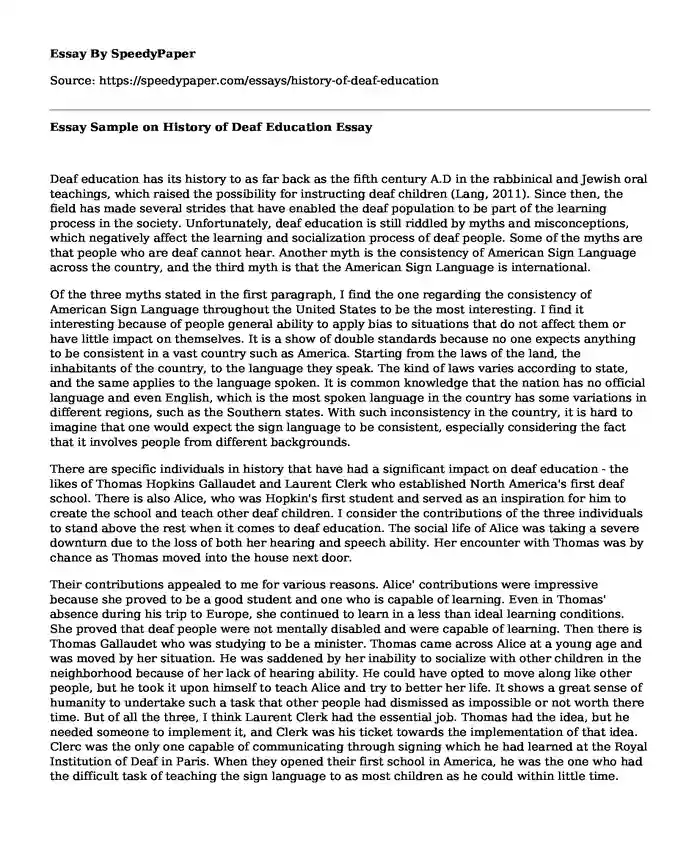
| Type of paper: | Course work |
| Categories: | Teaching School Languages Special education |
| Pages: | 3 |
| Wordcount: | 677 words |
Deaf education has its history to as far back as the fifth century A.D in the rabbinical and Jewish oral teachings, which raised the possibility for instructing deaf children (Lang, 2011). Since then, the field has made several strides that have enabled the deaf population to be part of the learning process in the society. Unfortunately, deaf education is still riddled by myths and misconceptions, which negatively affect the learning and socialization process of deaf people. Some of the myths are that people who are deaf cannot hear. Another myth is the consistency of American Sign Language across the country, and the third myth is that the American Sign Language is international.
Of the three myths stated in the first paragraph, I find the one regarding the consistency of American Sign Language throughout the United States to be the most interesting. I find it interesting because of people general ability to apply bias to situations that do not affect them or have little impact on themselves. It is a show of double standards because no one expects anything to be consistent in a vast country such as America. Starting from the laws of the land, the inhabitants of the country, to the language they speak. The kind of laws varies according to state, and the same applies to the language spoken. It is common knowledge that the nation has no official language and even English, which is the most spoken language in the country has some variations in different regions, such as the Southern states. With such inconsistency in the country, it is hard to imagine that one would expect the sign language to be consistent, especially considering the fact that it involves people from different backgrounds.
There are specific individuals in history that have had a significant impact on deaf education - the likes of Thomas Hopkins Gallaudet and Laurent Clerk who established North America's first deaf school. There is also Alice, who was Hopkin's first student and served as an inspiration for him to create the school and teach other deaf children. I consider the contributions of the three individuals to stand above the rest when it comes to deaf education. The social life of Alice was taking a severe downturn due to the loss of both her hearing and speech ability. Her encounter with Thomas was by chance as Thomas moved into the house next door.
Their contributions appealed to me for various reasons. Alice' contributions were impressive because she proved to be a good student and one who is capable of learning. Even in Thomas' absence during his trip to Europe, she continued to learn in a less than ideal learning conditions. She proved that deaf people were not mentally disabled and were capable of learning. Then there is Thomas Gallaudet who was studying to be a minister. Thomas came across Alice at a young age and was moved by her situation. He was saddened by her inability to socialize with other children in the neighborhood because of her lack of hearing ability. He could have opted to move along like other people, but he took it upon himself to teach Alice and try to better her life. It shows a great sense of humanity to undertake such a task that other people had dismissed as impossible or not worth there time. But of all the three, I think Laurent Clerk had the essential job. Thomas had the idea, but he needed someone to implement it, and Clerk was his ticket towards the implementation of that idea. Clerc was the only one capable of communicating through signing which he had learned at the Royal Institution of Deaf in Paris. When they opened their first school in America, he was the one who had the difficult task of teaching the sign language to as most children as he could within little time.
References
Lang, H. G., (2011). Perspectives of History of Deaf Education. In The Oxford Handbook of Deaf Studies, Language, and Education(2nd ed., Vol. I, pp. 7-16). Oxford: Oxford University Press. doi:10.1093/oxfordhb/9780195390032.001.0001
Cite this page
Essay Sample on History of Deaf Education. (2023, Jan 20). Retrieved from https://speedypaper.net/essays/history-of-deaf-education
Request Removal
If you are the original author of this essay and no longer wish to have it published on the SpeedyPaper website, please click below to request its removal:
- Bullying: Cause and Effect Essay Example
- Essay Example: Moses' vs. Billy Graham's Leadership
- Law Essay Example on Jurisdiction and Venue
- Comparative Ethnic Experience: Chinese-American and Hispanics, Italian-American
- Essay Example Dedicated to Evidence-Based Practice in Diabetes
- Free Essay Example on How Medicare for All Would Work
- Distinctions Between Qualitative and Quantitative Methods - Essay Sample
Popular categories




